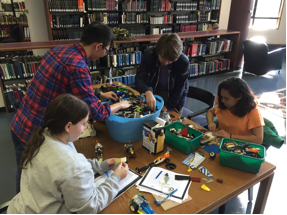Victor Regnier FAIA is working on a new book that deals with Longevity and Housing that Wiley will publish in 2017.
It looks at the implications of the growing worldwide population of people 85+ and 100+ and the housing and service options available to care for their needs in a residential, non-institutional context.
Charles A. Lagreco attended the ACSA Annual Meeting in 2015 to represent the USC School of Architecture as one of the 14 selected schools to participate in the NCARB IPAL initiative to integrate registration requirements with professional degree graduation. Professor Lagreco with coordinate the program at USC which is on track to start in the fall of the 2016-07 Academic year.
Michael Ellars, AIA, recently completed his first year as an instructor in the undergraduate Building Science program at the University of Southern California School of Architecture; the second semester project focused on competition entries for the Timber in the City competition co-sponsored by ACSA. In February, he presented a three-hour professional education course on accessibility changes in the California Building Code to the San Fernando Valley Chapter of the American Institute of Architects (http://www.aiasfv.org/newsletter/2015/12-2015Elevations.pdf). Ellars recently wrote an article about using Virtual Reality to boost the K-12 educational experience for Insights, an on-going publication series by DLR Group thought leaders (http://www.dlrgroup.com/insights/articles/ellars-virtual-reality/). His article, Virtual Reality: A Revolutionary Evolution in Building Design, was published in the February 2016 issue of Connection, the architecture and design journal of the Young Architects Forum of the American Institute of Architects (https://issuu.com/youngarchitectsforum/docs/160216_-_1401_-_vol_14_issue_01_dra/32).
Prof. Graeme M. Morland, Principal, GEM Architects, has just completed a series of schematic design sketches for a 25 unit, research scholar housing complex within the Huntington Garden estate in San Marino, Ca. The project design was greatly influenced by the large cloister and garden cells of the Carthusian Monastery of Pavia, Italy, which Morland visited many times with USC architecture students when he directed the study abroad program in Italy.
Assistant Professor David Jason Gerber was invited to co-Chair the “Positions on Smart Environments” Special Panel at the 2016 ACSA national convention this year. Professor Gerber will participate at this years’ Simulation in Architecture and Urban Design conference in London to present his research on Multi-Agent Systems for Design. Professor Gerber has been awarded a Scholar in residence Fellowship by The Borchard Foundation to pursue a research titled “Descriptive Surfaces, From Desargue to De Casteljau and their mathematical influence on instrumental and design knowledge in Architecture.”
Alexander Robinson was invited to present his design research on Rome’s Tiber River at the International Federation of Landscape Architect’s 2016 Conference in Turin, Italy in April. He exhibited this work in March at the American Academy in Rome’s Cinque Mostre exhibit curated by Illaria Gianni.
Vittoria Di Palma’s book, Wasteland, A History (Yale: 2014), was awarded the 2016 Elisabeth Blair MacDougall Book Award by the Society of Architectural Historians. This prize recognizes annually the most distinguished work of scholarship in the history of landscape architecture or garden design. At the Society of Architectural Historians’ meeting in Pasadena, Vittoria was elected Vice President of the SAH Landscape History Chapter.
Jennifer Siegal, founder of Los Angeles-based Office of Mobile Design (OMD), has been announced as the winner of the fourth arcVision Prize – Women and Architecture, an international award to women’s architecture organized by Italcementi. Siegal was unanimously chosen by the jury for being “a fearless pioneer in the research and development of prefabricated construction systems, at low prices for disadvantaged users and areas, who has been able to invent and build practical solutions and a new language for mobile and low-cost housing.”
The keynote presentation of Prof Goetz Schierle at the IEREK Conference Cairo will be posted at: http://uscarch.com/structures/Arch499/index-DG.html
Trudi Sandmeier recently chaired the jury for the Los Angeles Conservancy’s annual Preservation Awards honoring the best conservation projects in Los Angeles County.
Mina Chow has launched an international social media campaign for FACE OF A NATION on Facebook, Instagram, and Twitter to provide a public platform for intelligent discussion about the role of architecture and design in cultural diplomacy and conflict resolution. As a result of the film’s significance, Skywalker Sound (George Lucas/THX) has agreed to join our team, and they are exploring ways they will contribute. A venture capitalist has invested further resources with another generous contribution. Mina also has presented her works-in-progress at several symposiums at USC Annenberg’s Center for Public Diplomacy between 2014-2016. FACE OF A NATION showcases America’s best architects and engineers (including Buckminster Fuller, Ray and Charles Eames, and Davis Brody) working together to promote the American image. The film has progressed to fine-cut with 34 animations-in-progress.
Kyle Konis will give a presentation entitled Daylighting Design Performance Metrics to Enhance Health and Well-being at the National AIA Convention in Philadelphia on May 20.
Adjunct Associate Professor Michael Hricak, FAIA, recently participated in a Metropolis Magazine “Think Tank” panel moderated by long-time Publisher/Editor in Chief Susan S. Szenasy held at the Los Angeles offices of AECOM. Professor Hricak represented the southern California design education community addressing current housing policies, real estate trends and workplace design and innovation. Also on the panel were representatives of the real estate, design and business communities. DISCUSSION STATEMENT: “Urban vs. Suburban…where to place the workplace.’ As technology, work-styles, generational demographics, work-life balance issues and the war for talent continue to drive workplace evolution, our Think Tank panel will discuss how these issues affect a company’s decision on where to physically place the workplace. Traditional considerations of cost, ‘a downtown address’, and ease of mass transportation, to name a few, often define the workplace in an urban setting. Can the suburban setting better address the drivers of the evolving workplace given real estate costs in urban centers (both office lease and housing) such as home-based working, reduction of carbon footprint, and the rise of co-working/co-shared work environments? We will explore how the evolving workplace is driving new thinking around the importance of “address.””
Professor Kelly Shannon has been selected as a Research Fellow for the Landscape Architecture Foundation’s (LAF) 2016 Case Study Investigation (CSI) program. Professor Shannon is one of six fellows who will each lead a team who will assess and document benefits of high-performing landscape projects, resulting in Case Study Briefs for LAF’s Landscape Performance Series, an online, open-source database of paradigmatic landscape projects. The projects and firms that Shannon will be working with are Vista Hermosa Park (Mia Lehrer + Associates), South Los Angeles Wetland Park (Psomas), and Shenzhen Bay (SWA Group).
Joon-Ho Choi has been awarded a Zumberge Grant in support of his project, “User-Centered Integrative Building System Control Using Human Bio-Signals for Environmental Health and Sustainability.” “Joon-Ho has brought strong promise to the School’s research agenda, through which architecture will gain new ground in our concerns for the environment,” said Dean Qingyun Ma. Choi’s research focuses on developing intelligent environmental controls in buildings based on occupants’ physiological responses and maximizing the building’s environmental performance
Rob Ley’s design office was a winner of the Architizer A+ 2016 Award for the Eskenazi Hospital parking structure facade. His firm will be recognized in an event held in New York on May 12th.
Diane Ghirardo presented an invited paper on Lucrezia Borgia’s treasury at a conference on The Borgias in Art in Xåtiva, Spain, in May.
Eight teams of students in the graduate and fifth year undergraduate programs, led by Kim Coleman and Warren Techentin in conjunction with USC Architecture graduates Chiu Man Wong and Maria Warner Wong, of WOW Architecture in Singapore, designed proposals for a creative financial hub to be built in Bhartiya City, a new city currently in construction in Bangalore, India. Thanks to the generosity of the Bhartiya corporation, the group began the semester with a twelve day trip to India, researching the country’s culture and traditions. Design strategies for the two-million square foot project explore typologies that provide a strong identity and sense of place and that encompass a mix of housing, office, and retail functions, resulting in a mix of scale and use and a commitment to public open space. Snehdeep and Arjun Aggarwai of Bhartiya came to USC for the final reviews and celebratory reception on Thursday, 28th. An exhibit and publication is planned for fall, 2016.
Gary Paige’s award-winning proposal for the Los Angeles Forum for Architecture and Urban Design competition Dingbat 2.0 was featured in the new book Dingbat 2.0: The Iconic Los Angeles Apartment as Projection of a Metropolis, edited by Thurman Grant and Joshua Stein, (DoppelHouse Press, 2016).
Karen Kensek is planning the tenth annual BIM Symposium at USC for Friday, July 22nd. The theme of this year’s presentations is efficient, productive, and profitable workflows. The 2015 BIM Symposium focused on visual programming.
Hraztan Zeitlian directed the design of the Los Angeles Southwest College School of Career and Technical Education building that received an American Institute of Architects Los Angeles Valley Chapter Design Award.
Professor Marc Schiler moderated a panel on “Glare and Solar Convergence” at the Façade Tectonics Forum at the University of Texas, San Antonio, on April 7, 2016. He is working hectically on the scientific program for the Passive and Low Energy Architecture (PLEA2016) conference to be held in Los Angeles from July 11-13, 2016. This is the first time that the conference has been held in the United States in its 35 year history. Approximately 500 abstracts were accepted out of 1000 submissions. Based on completed manuscripts, about 300 full papers were accepted for presentation and publication. Thom Mayne and Ed Mazria are two of the keynote speakers. There will be tours of sustainable built environments of Los Angeles.
Lecturer Scott Uriu and his firm Baumgartner+Uriu is one of the 10 invited architects, artists and designers, invited to participate in the J. Irwin and Xenia S. Miller Prize as part of the inaugural 2016 symposium for Exhibit Columbus, “Foundations and Futures,” held Sept. 29 to Oct. 1. In Columbus Indiana. Exhibit Columbus is an exhibition put on by the city of Columbus Indiana in association with Ball State University, The Ohio State University, University of Cincinnati, University of Kentucky, University of Michigan, the Indiana University Center for Art+Design, and Columbus-Ivy Tech. http://www.exhibitcolumbus.org/
Douglas Noble and Karen Kensek are hosting the Façade Tectonics World Congress in downtown Los Angeles October 10-11, 2016.
Professor James Steele has been awarded a 2016-17 Fulbright grant to Malaysia. Next semester, Professor Steele will be working with Ezrin Arbi, Professor Emeritus at the University of Malaya, on a multi-publication project on the mosques and vernacular housing of both Malaysia and the Minangkabau people, an ethnic group of West Sumatra, Indonesia. Steele previously worked with Arbi to establish the USC Architecture study abroad program in Malaysia, and in 2012, Arbi asked Steele to collaborate with him on the project. Steele explained, “Arbi, now an octogenarian, is a devout Muslim of Minangkabau origin and has been collecting materials on both the distinctive vernacular houses and mosques of his homeland, and those of his adopted country of Malaysia, since he was a student in Jakarta more than 50 years ago.” Steele plans to frame Arbi’s materials by constructing the context of Minang and Malaysian villages. During the grant period, a group, including Steele, Arbi, and a few University of Malaysia colleagues, will be photographing houses and mosques within their village contexts using a drone. This will be done in both Sumatra and Malaysia.
On April 27 Edward Bosley, the Director of the Gamble House for USC, spoke to 1st, 2nd and 3rd-year students at Plymouth University School of Architecture in the UK about the Gamble House. The students were particularly interested in the Greenes’ use of materials and their attention to the details of craftsmanship, and generally their eyes were opened to the existence of architecture as a fine art.
Dimitry Vergun retired after teaching at the USC School of Architecture for over 40 years. Vergun is considered one of the finest teachers in the program, and taught in the building science studios for decades. He remains a beloved professor for all of his former students.
Adjunct Assistant Professor Tigran Ayrapetyan together with the USC undergraduate Building Science students participated in the symposium organized by Simpson Strong-Tie at their Riverside facility on 4-8-16. The participants were students from UCI, CSULB, CSUF, and USC. The students representing USC won the Simpson Engineering Jeopardy competition at the event.
Eric Haas, Adjunct Associate Professor, was the recipient of a 2016 USC Mentoring Award given by USC’s Center for Excellence in Teaching for his work with undergraduate students. His firm DSH // architecture exhibited their contribution Spiral Kitty, a 3d-printed reciprocal shelter for cats, at a benefit for Architects for Animals in March. He also exhibited Efflorescence Cognitionum, a microlibrary assembled from vintage card catalog drawers created with USC librarians Melissa Miller and Marje Schuetze-Coburn, on the USC campus as part of the Visions and Voices event “Microlibraries in the Everywhere.” His firm is currently at work on several preschool and charter school projects, among others.
The Courtyard at La Brea, a low income family housing project for persons with special needs located in the City of West Hollywood, by MUTLOW + TIGHE, (John V Mutlow, professor, and Patrick Tighe, professor of practice), is featured in the April 4 – 16 issue of NEW YORK magazine in an article titled ‘The Urbanist: Los Angeles Architecture. New buildings embrace nature, density and public spaces’, and in an online article by the Daily Intelligencer titled ‘A Guide to Los Angeles Widely Inventive New Architecture.’ See link: http://nymag.com/daily/intelligencer/2016/04/guide-to-las-inventive-new-architecture.html

 Study Architecture
Study Architecture  ProPEL
ProPEL 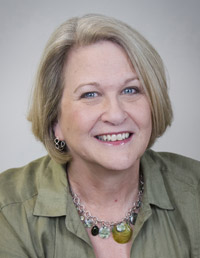
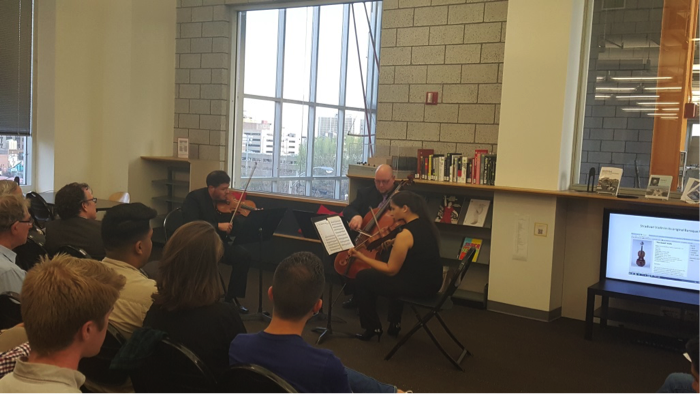
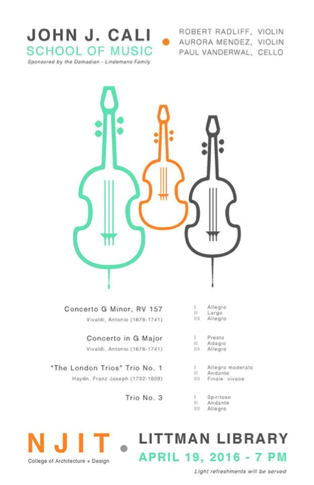 Understanding the idea of the “total work of art” can be an important lesson for students and, recently, more attention has been drawn to it. Gesamtkunstwerk has once again become a subject of numerous discussions, proving that this idea is still relevant. The exhibition, “Der Hang zum Gesamtkunstwerk” in Kunsthaus Zurich (1983) and in Vienna (1984), a recreation and performance of Skriabin’s “Prometheus” at Yale University (2010), and the latest collection of essays, “The Death and Life of the Total Work of Art,” presented at the Bauhaus Colloquium in 2013, highlight the historic meaning of the term, and apply it to more recent events and works. Technological advancements provide the tools that allow for the creation of immersive artistic experiences, which remove “the borderline between object and observer, stage and audience, art work and spectator,”
Understanding the idea of the “total work of art” can be an important lesson for students and, recently, more attention has been drawn to it. Gesamtkunstwerk has once again become a subject of numerous discussions, proving that this idea is still relevant. The exhibition, “Der Hang zum Gesamtkunstwerk” in Kunsthaus Zurich (1983) and in Vienna (1984), a recreation and performance of Skriabin’s “Prometheus” at Yale University (2010), and the latest collection of essays, “The Death and Life of the Total Work of Art,” presented at the Bauhaus Colloquium in 2013, highlight the historic meaning of the term, and apply it to more recent events and works. Technological advancements provide the tools that allow for the creation of immersive artistic experiences, which remove “the borderline between object and observer, stage and audience, art work and spectator,” 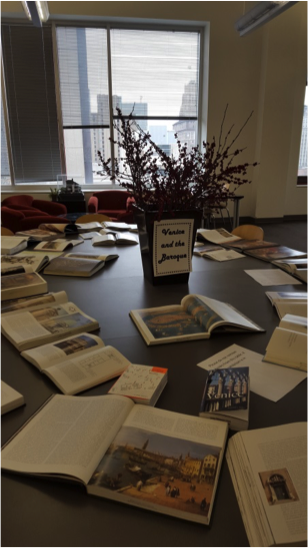 university community, the concerts are mostly focused on the needs of the College of Architecture and Design population. The concert series directly supports several courses, including “Music for Designers,” which is focused on the theory and history of music, its relation to culture, and its use in cinema, digital and interactive media. Each concert is accompanied by a short lecture and PowerPoint presentation related to the theme of a concert, providing context as well as background information. Students design posters advertising the series. A book exhibition further enhances each event. The collaboration with musicians–a group of talented and dedicated educators–helps to develop programs that are both popular and educational. These events take place in an intimate “chamber-like” environment of the college Library which is located in the physical center of the building. Folding chairs that can be easily assembled form an auditorium. The Library remains open and fully functional during these events, which usually take place at night. Light refreshments help to create a pleasant and relaxing atmosphere. Free of charge, funded and supported by the college administration and alumni, these concerts have become popular and well attended. They help to alleviate stress, expand students’ horizons, improve their exposure to music, link performed musical compositions to the subjects of study in classes and studio, provide a historical context, and establish the Library as a place which can provide cultural and educational opportunities, often not possible within a curricular setting.
university community, the concerts are mostly focused on the needs of the College of Architecture and Design population. The concert series directly supports several courses, including “Music for Designers,” which is focused on the theory and history of music, its relation to culture, and its use in cinema, digital and interactive media. Each concert is accompanied by a short lecture and PowerPoint presentation related to the theme of a concert, providing context as well as background information. Students design posters advertising the series. A book exhibition further enhances each event. The collaboration with musicians–a group of talented and dedicated educators–helps to develop programs that are both popular and educational. These events take place in an intimate “chamber-like” environment of the college Library which is located in the physical center of the building. Folding chairs that can be easily assembled form an auditorium. The Library remains open and fully functional during these events, which usually take place at night. Light refreshments help to create a pleasant and relaxing atmosphere. Free of charge, funded and supported by the college administration and alumni, these concerts have become popular and well attended. They help to alleviate stress, expand students’ horizons, improve their exposure to music, link performed musical compositions to the subjects of study in classes and studio, provide a historical context, and establish the Library as a place which can provide cultural and educational opportunities, often not possible within a curricular setting.